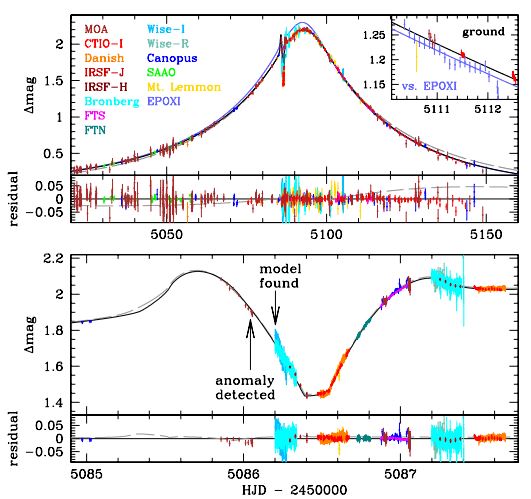
by Jennifer Yee (SAO), Sydney Anderson (Swarthmore), Linda Vu (Swarthmore)
Gaudi & Gould (1997) showed that the parameters of a planet (s and q) can be approximated analytically based on light curve observables.

Based on the microlensing light curve, figure out the following properties of the microlensing event:
| Your answers | ||
|---|---|---|
| Time of the peak of the event = t0: | ||
| Change in magnitude = Δm: | ||
| Maximum magnification = Amax: | ||
| Impact parameter = |u0|: | ||
| Magnitude at Half-Maximum = | ||
| Full Width Half Maximum = tFWHM: | ||
| Einstein Timescale = tE: |
| Your answers | ||
|---|---|---|
| Time of the the planet perturbation = tplanet : | ||
| Time scaled to the Einstein timescale = τ = |tplanet - t0|/tE : | ||
| Source-lens separation = u = √(u02 + τ2) : | ||
| y± = ± (½) (√(u2 + 4) ± u) : | ||
| Is the perturbation a major image (+) or minor image (-) perturbation? | Location of the planet = s : |
| Your answers | ||
|---|---|---|
| Planet Einstein Timescale = tp,E ~ tFWHM : | ||
| Mass Ratio = q = (tp,E / tE)2: |
| Planet | q = Planet Mass/Sun's Mass |
|---|---|
| Jupiter | 10-3 |
| Neptune | 5 x 10-5 |
| Earth | 3x 10-6 |
| Your answer | ||
|---|---|---|
| Is the planet more similar to Earth, Neptune, or Jupiter? |
You can also view the original paper: Muraki et al. 2011 ApJ 741, 22